June 22, 2025

The article examines the various schedules of reinforcement in Applied Behavior Analysis (ABA) therapy, emphasizing their crucial role in effectively managing and modifying behaviors.
Have you considered how these reinforcement strategies could transform your approach? Understanding and implementing these schedules can lead to more effective interventions, making a compelling case for their integration in ABA practices.
In the realm of Applied Behavior Analysis (ABA), the effectiveness of behavior management hinges significantly on the strategies employed to reinforce desired actions. Notably, there is a projected 25% increase in demand for Board Certified Behavior Analysts (BCBAs) by 2026. This statistic underscores the urgency for practitioners to deepen their understanding of reinforcement schedules, which is crucial for both practitioners and clients. This article delves into nine distinct schedules of reinforcement, offering insights into how each approach can enhance behavior acquisition, maintenance, and overall therapeutic success. As the landscape evolves, practitioners must consider:
The demand for (BCBAs) is projected to surge by an astounding 25% by 2026. In this rapidly expanding field of Applied Behavior Analysis (ABA) therapy, Hire ABA stands out as a specialized recruitment platform dedicated to connecting BCBAs with premier job opportunities. This platform is not just a tool; it plays a crucial role in optimizing the hiring process for both job seekers and employers.
Are you struggling to find the right candidates or the perfect job? Hire ABA is designed to provide a supportive and efficient experience, ensuring that qualified professionals can discover positions that truly align with their skills and career aspirations. By leveraging data-driven insights, Hire ABA significantly enhances the job matching process, facilitating career advancement for BCBAs in an evolving landscape.
This strategic approach addresses immediate hiring needs while contributing to the overall efficiency of recruitment in the healthcare sector. It reflects the increasing importance of specialized platforms in meeting the demands of a growing workforce. With Hire ABA, you can trust that your recruitment challenges will be met with expertise and reliability. Explore the opportunities that await you today.
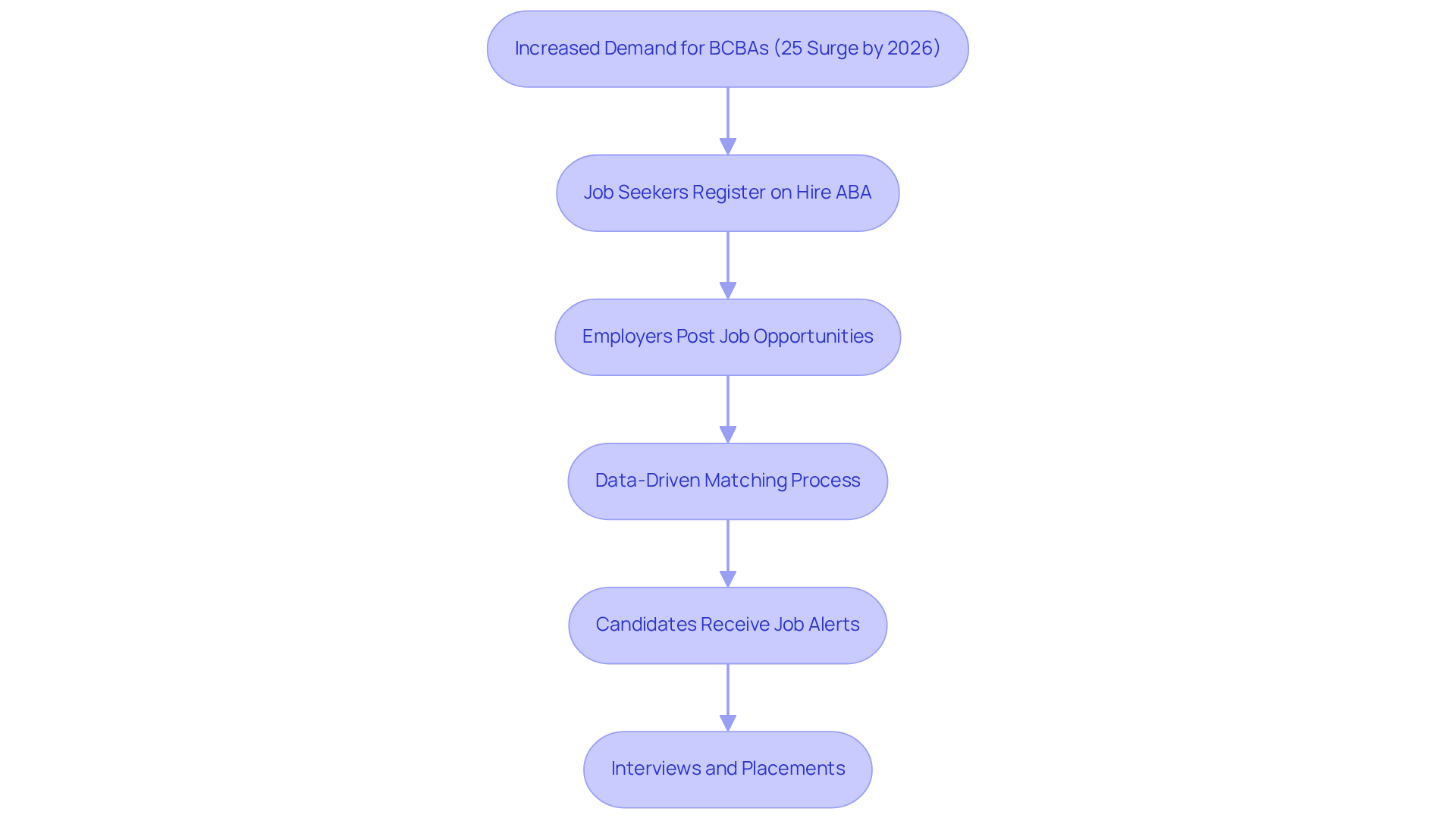
A continuous reinforcement schedule entails offering a reinforcer each time a desired action occurs. This method is particularly effective during the initial learning phases, as it fosters a robust connection between the action and the reward. For instance, a child may receive compliments or a small reward every time they complete a task, motivating them to repeat the behavior.
Research indicates that continuous support can lead to swift behavior acquisition, with studies showing a significant increase in the likelihood of behavior repetition. This schedule is crucial in ABA therapy, laying the groundwork for more complex reward strategies, including ABA, such as fixed ratio and variable ratio schedules, which practitioners may employ later.
However, it is vital to recognize that while continuous support is effective, there exists a potential risk of extinction if this support is withdrawn. Therefore, understanding the balance between immediate rewards and long-term change is essential for successful ABA interventions.
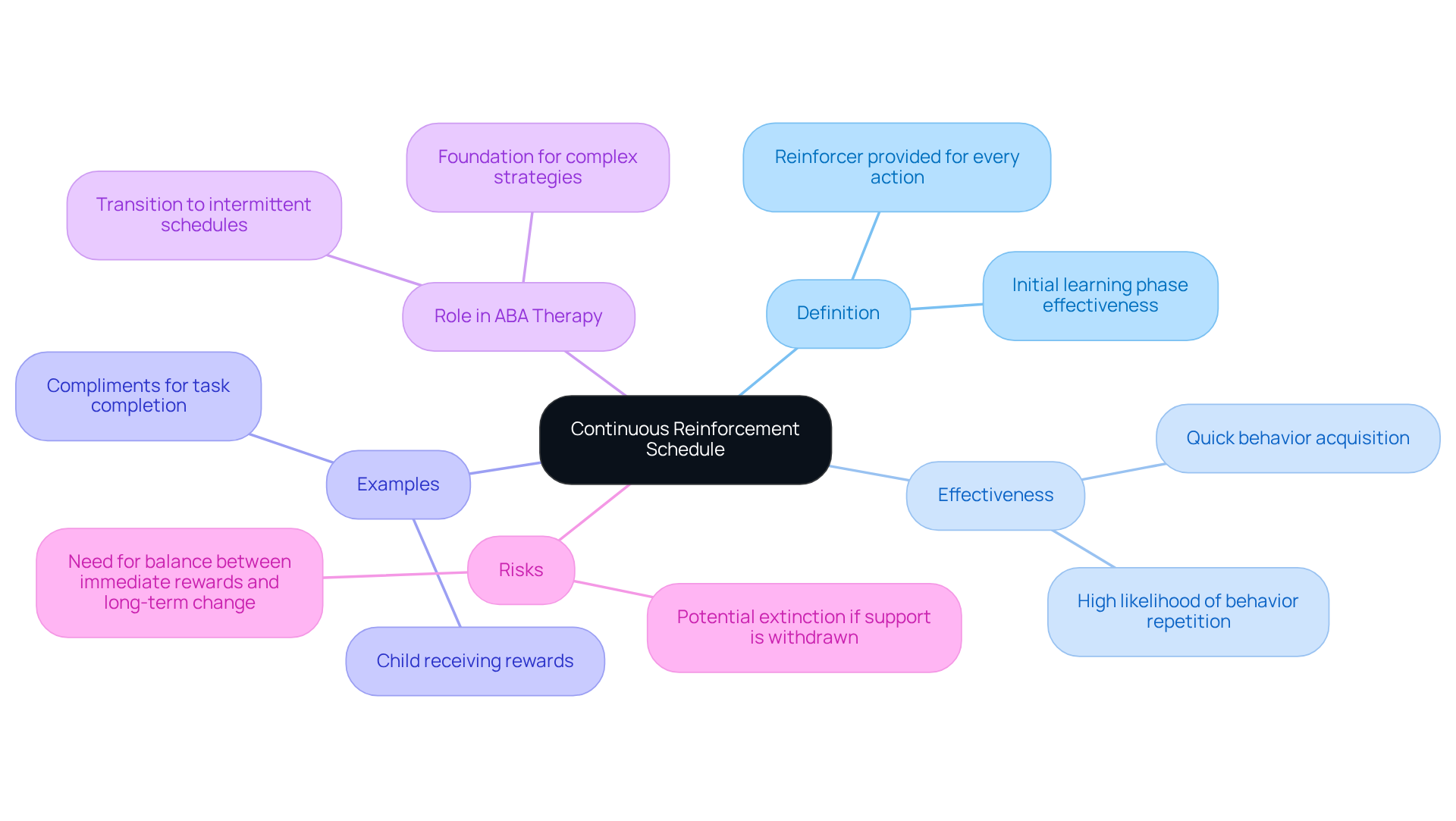
Intermittent reward systems are examples of schedules of reinforcement aba, providing incentives only after specific occurrences of the desired action, rather than on a regular schedule. This unpredictability fosters stronger and more enduring actions. For instance, a child may receive a reward for completing a task on some occasions but not others.
Studies indicate that actions sustained through sporadic rewards are less likely to fade, as individuals persist in the activity in anticipation of a reward. This approach not only fosters resilience but also improves long-term behavioral change, making it a powerful instrument in the management of actions through schedules of reinforcement aba.
Statistics from a study involving college male subjects reveal that participants under intermittent reward conditions demonstrated greater persistence, with a response rate that significantly improved over time. The effectiveness of this approach is echoed by behavior analysts like Marie-Claire Villeval, who noted that "intermittent rewards lead to more persistence and higher total effort," emphasizing in fostering sustained engagement and motivation.
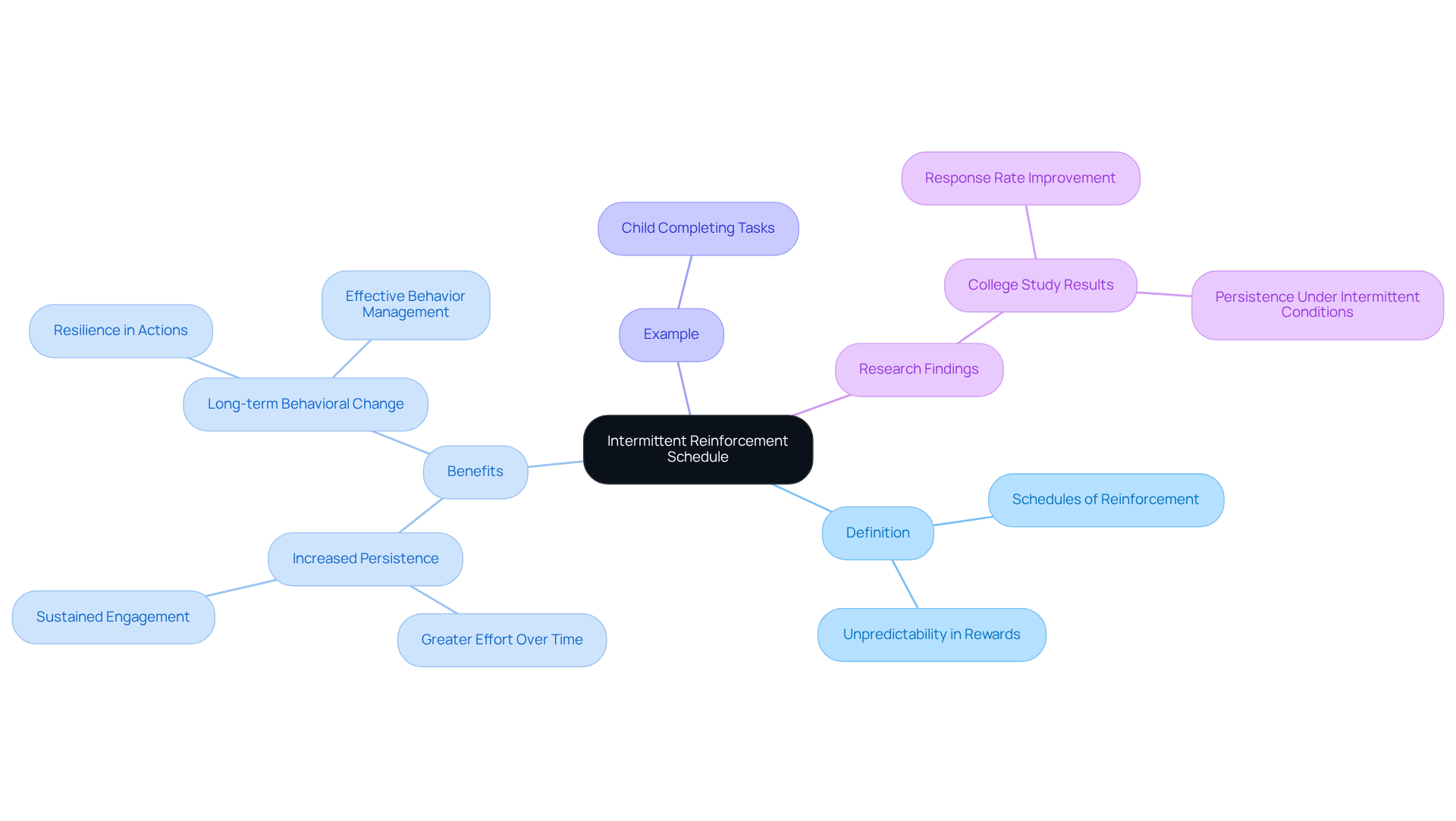
The anticipated 25% rise in demand for Board Certified Behavior Analysts (BCBAs) by 2026 underscores the critical need for effective recruitment strategies in the field of (ABA).
A fixed support plan based on schedules of reinforcement ABA provides incentives after a specific number of responses or after a designated time interval. For instance, in a fixed-ratio plan, a child might receive a sticker after every five correct answers. This predictability can lead to high rates of responding, as individuals learn to anticipate the reward. However, it may also result in pauses in responding immediately after reinforcement, known as post-reinforcement pauses.
Research indicates that these pauses can vary in duration, impacting overall response rates and learning efficiency. Comprehending the dynamics of fixed timings enables practitioners to effectively organize learning environments.
In clinical settings, schedules of reinforcement ABA are frequently employed in token economies, utilizing fixed ratio systems to reward clients with tokens for certain actions, which can be traded for privileges. This method not only reinforces desired behaviors but also enhances motivation and participation in therapeutic activities.
As Steven Zauderer, CEO & Founder, observes, "The tactical application of reward systems is crucial to effective ABA therapy."
To address the growing demand for qualified professionals, consider utilizing Hire ABA for recruitment. This platform offers a reliable solution to enhance learning outcomes through efficient incentive strategies.
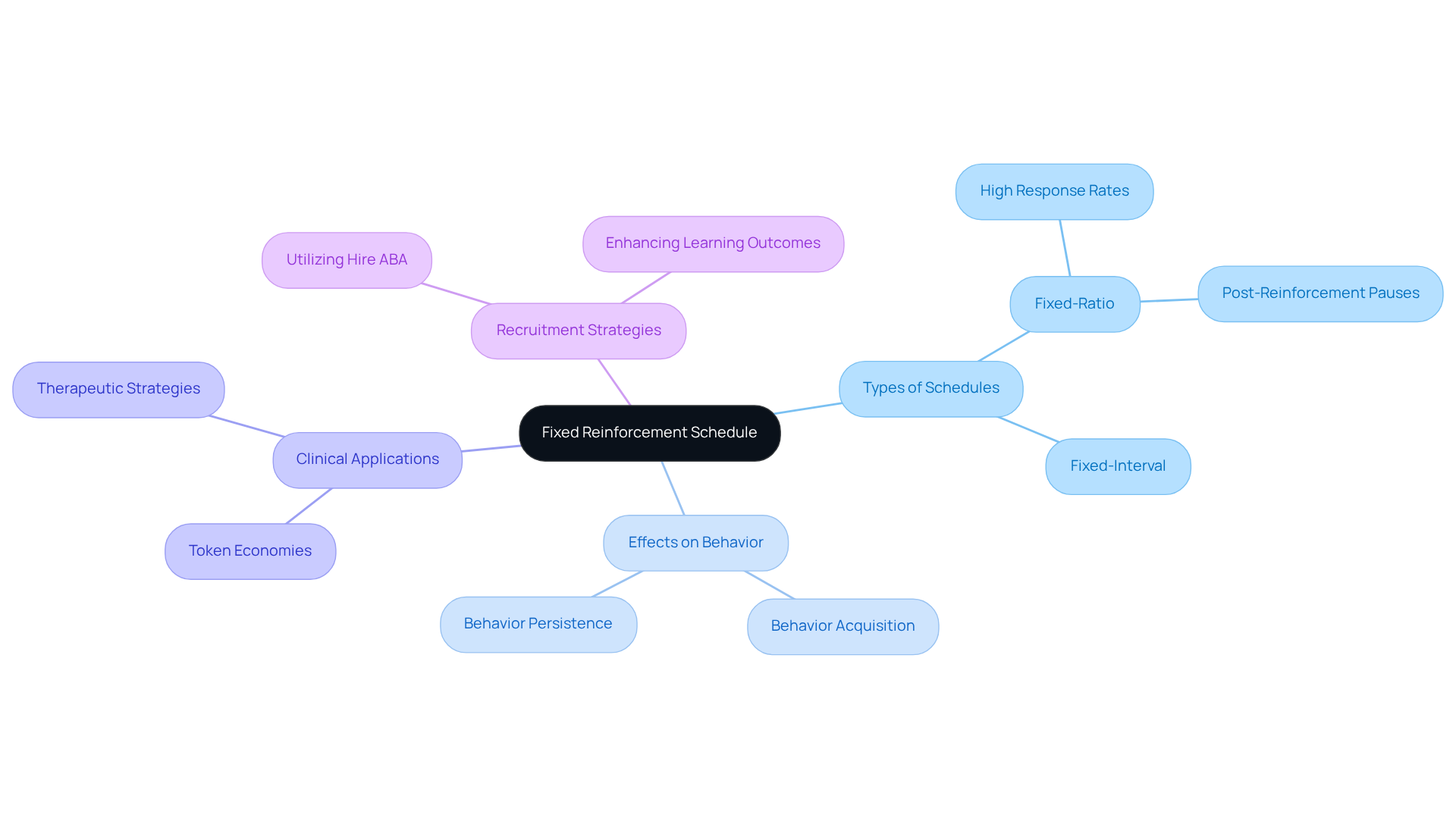
Variable reward schedules serve as powerful incentives, delivering rewards after an unpredictable number of responses or at varying time intervals. This element of surprise significantly enhances motivation and engagement. The unpredictability encourages individuals to persist in their efforts, as they remain uncertain about when the next reward will be given.
For example, a child may earn a reward after typically three to five correct answers, which not only keeps them involved but also motivates them to continue demonstrating preferred actions. Although specific statistics on engagement rates are not provided, research indicates that variable rewards can bolster participation and commitment in therapy settings.
Practical applications of schedules of reinforcement aba in therapy include:
The advantages of variable reward systems extend beyond mere compliance; they cultivate resilience and adaptability in clients, equipping them with the skills to maintain positive actions over time.
To optimize the effectiveness of variable incentives, healthcare employers should track client progress and adjust the schedules of reinforcement aba to meet individual needs. This ensures a tailored approach that fosters long-term behavioral change.
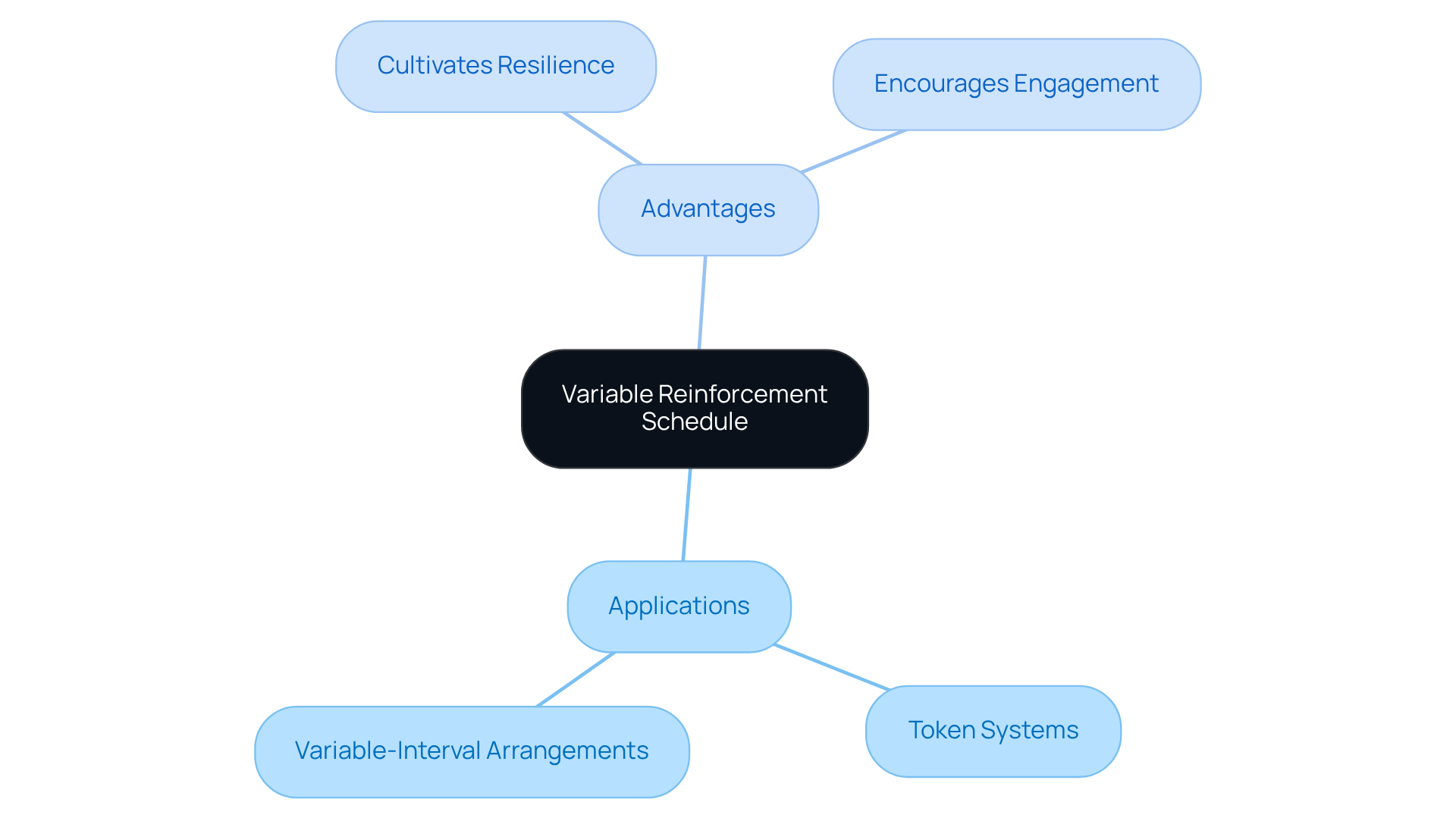
Fading techniques are essential in the realm of skill acquisition, as they involve the gradual reduction of assistance or prompts given to learners. This method not only fosters independence but also empowers individuals to perform tasks with decreasing support over time.
Consider a scenario where a therapist initially provides full physical guidance for a task; over time, this support is systematically diminished until the learner can execute the task independently. This approach is not merely beneficial; it is a cornerstone of ABA therapy, crucial for cultivating confidence and self-reliance in individuals' abilities.
Have you ever reflected on how much support your learners require? Understanding the can be transformative. By implementing these techniques, practitioners can significantly enhance the learning experience, enabling individuals to thrive with greater autonomy. Therefore, consider the implications of fading in your practice and the profound impact it can have on skill development.
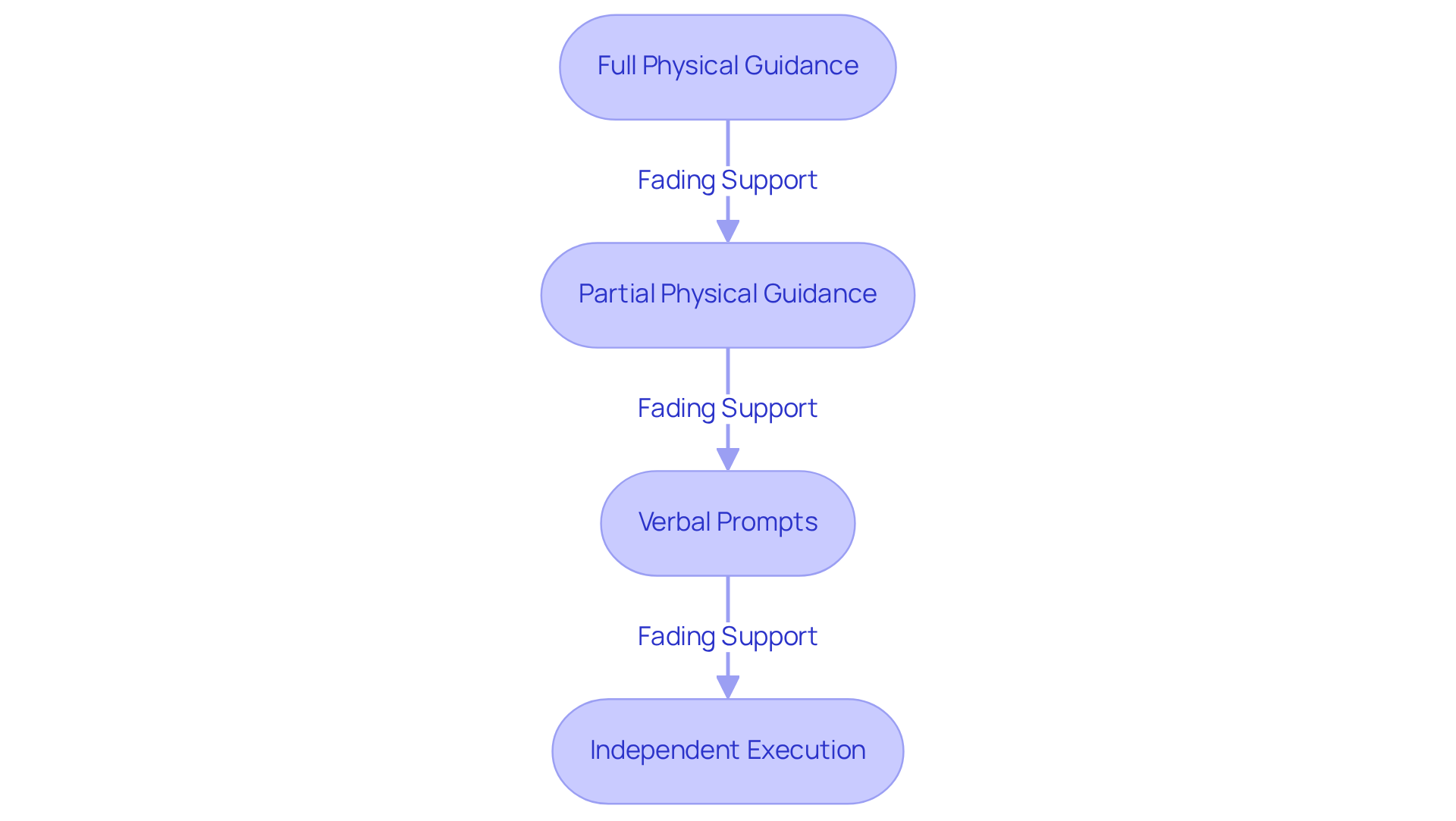
Data-driven adjustments are essential in the therapeutic landscape, involving the systematic collection and analysis of client behaviors and responses during sessions. This method empowers practitioners to grounded in empirical evidence rather than personal judgment.
For instance, when data reveals that a specific support method lacks effectiveness, therapists can swiftly modify their approach to align more closely with the client's needs. This continuous assessment guarantees that therapy remains responsive and effective, ultimately enhancing client outcomes.
Are you ready to elevate your practice by leveraging data-driven insights?
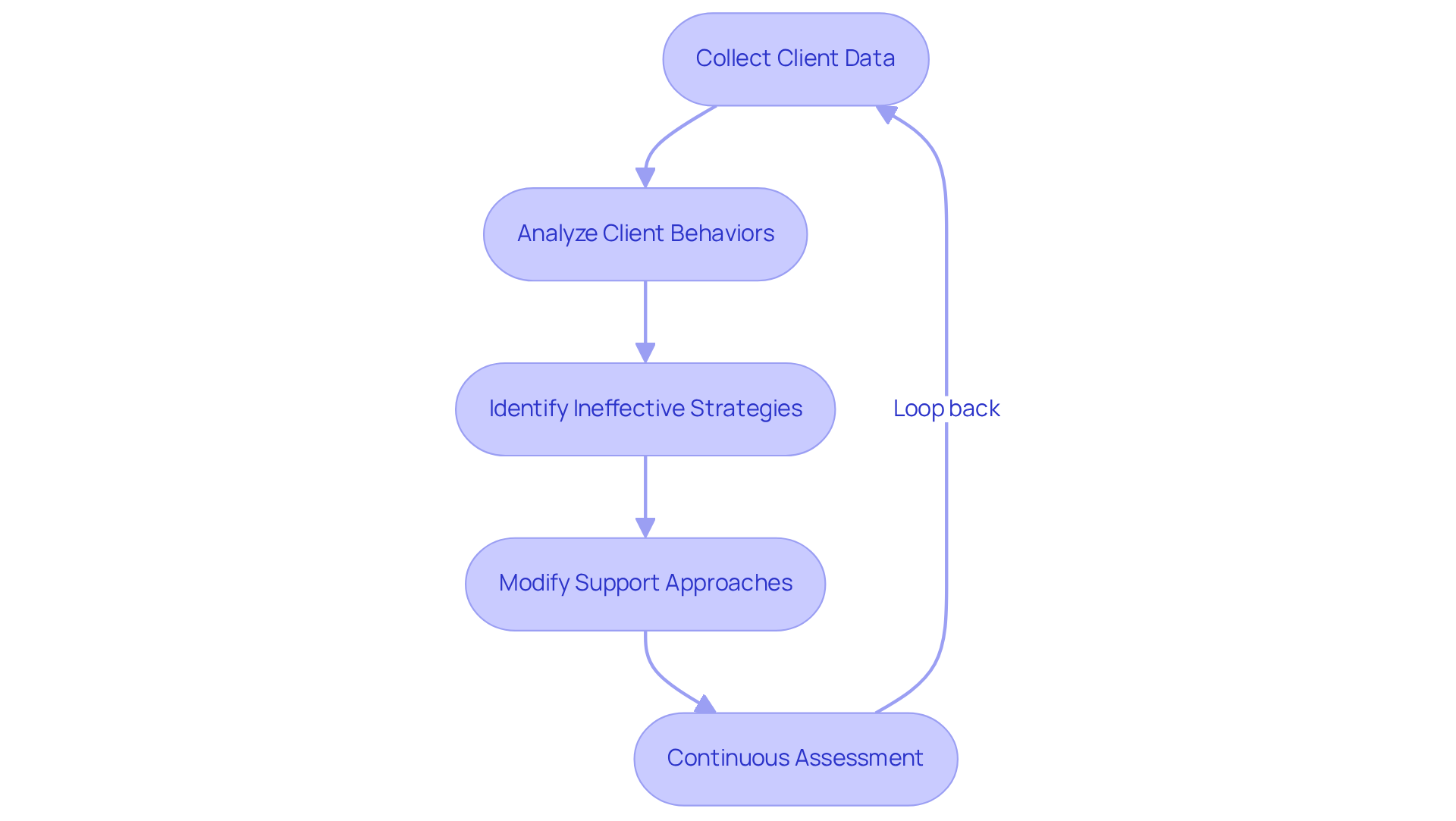
The kind of reward system employed plays a crucial role in influencing extinction rates. Actions that receive consistent support tend to diminish more rapidly once that support ceases. For instance, consider a child who is rewarded every time they complete a task; if the reward is withdrawn, the child may quickly abandon the task. Conversely, actions that are supported sporadically exhibit greater resilience to extinction. A child who receives occasional rewards is likely to persist in the action, driven by the anticipation of future rewards.
Recent studies reveal that partial rewards lead to slower learning but enhance resistance to extinction. This underscores the effectiveness of intermittent schedules in behavior management. For example, research indicates that rats receiving 50% rewards demonstrated greater resistance to extinction compared to those receiving 100% rewards.
Real-world applications, such as the operation of slot machines in casinos, exemplify how unpredictable rewards can sustain interest over time. As David G. Myers aptly notes, 'Slot machines at casinos function on incomplete timelines,' highlighting the practical implications of these incentive dynamics.
ABA practitioners emphasize the importance of understanding these dynamics, asserting that effective behavior management hinges on the strategic use of reward systems to foster .
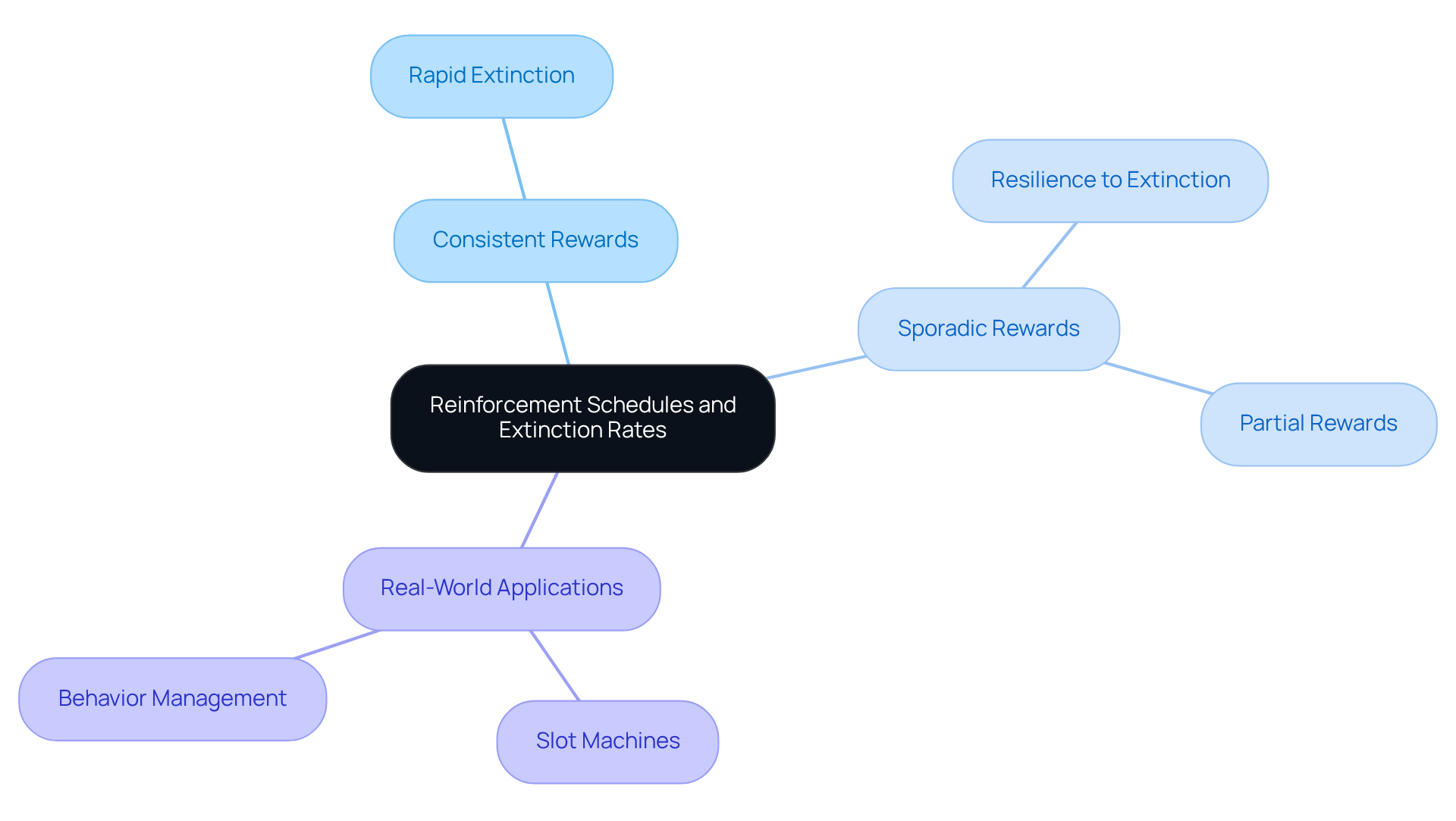
Monitoring and evaluation are vital for enhancing the schedules of reinforcement ABA in therapy. Consistent data gathering on client reactions to support strategies is essential for assessing their effectiveness. Studies reveal that consistent data collection can lead to a 30% increase in positive behavioral outcomes. Moreover, 90% of individuals achieve remarkable progress when caregivers are actively involved in therapy. This highlights the critical role of ongoing assessment and caregiver participation in the therapeutic process.
When therapists observe that a particular reward system is not yielding the expected outcomes, they can based on the insights collected. This proactive approach aligns interventions with the client's evolving needs and enhances the overall effectiveness of ABA therapy by utilizing schedules of reinforcement ABA.
Furthermore, caregiver education plays a vital role in improving support and decision-making, significantly impacting treatment outcomes. Utilizing the latest tools for data collection—such as automated behavior logs, frequency/event recording, and ABC data collection—allows practitioners to streamline the assessment process. This ensures timely modifications that foster better therapeutic outcomes.
Additionally, transparent data sharing with parents fosters trust and collaboration in the therapeutic process, further enhancing the effectiveness of ABA therapy. Ultimately, the integration of systematic monitoring and assessment into ABA practices empowers therapists to make informed decisions, leading to more successful interventions.
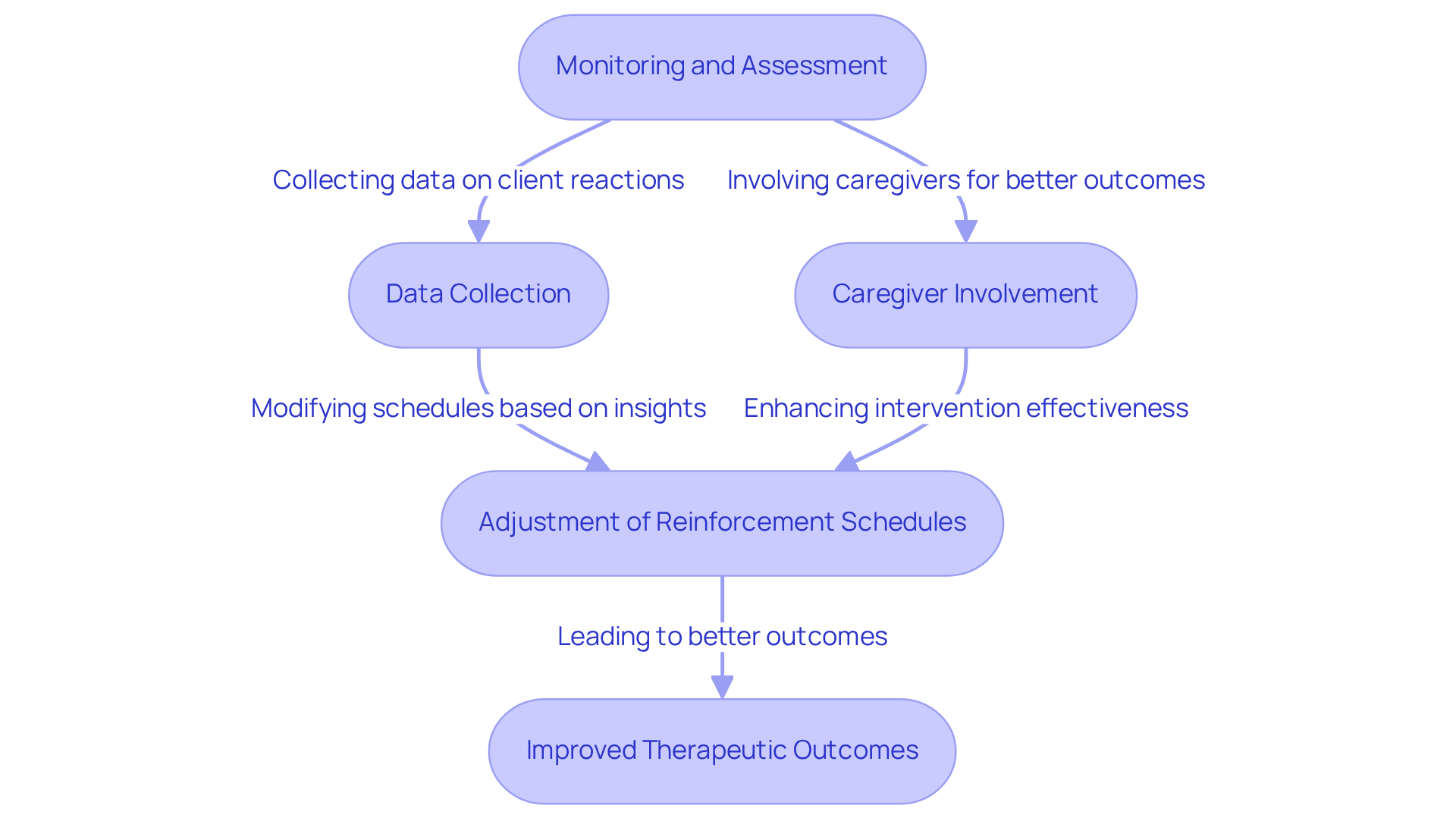
Real-life instances of schedules of reinforcement ABA illustrate their practical application in ABA therapy. Consider this: an educator may implement a fixed-ratio arrangement by rewarding students with additional recess time upon completing a specific number of assignments. Alternatively, a therapist might utilize by providing praise or tokens after an unpredictable number of correct responses during a session. These examples underscore how schedules of reinforcement ABA can be customized to suit various contexts and individual needs, ultimately enhancing the effectiveness of behavior management strategies.
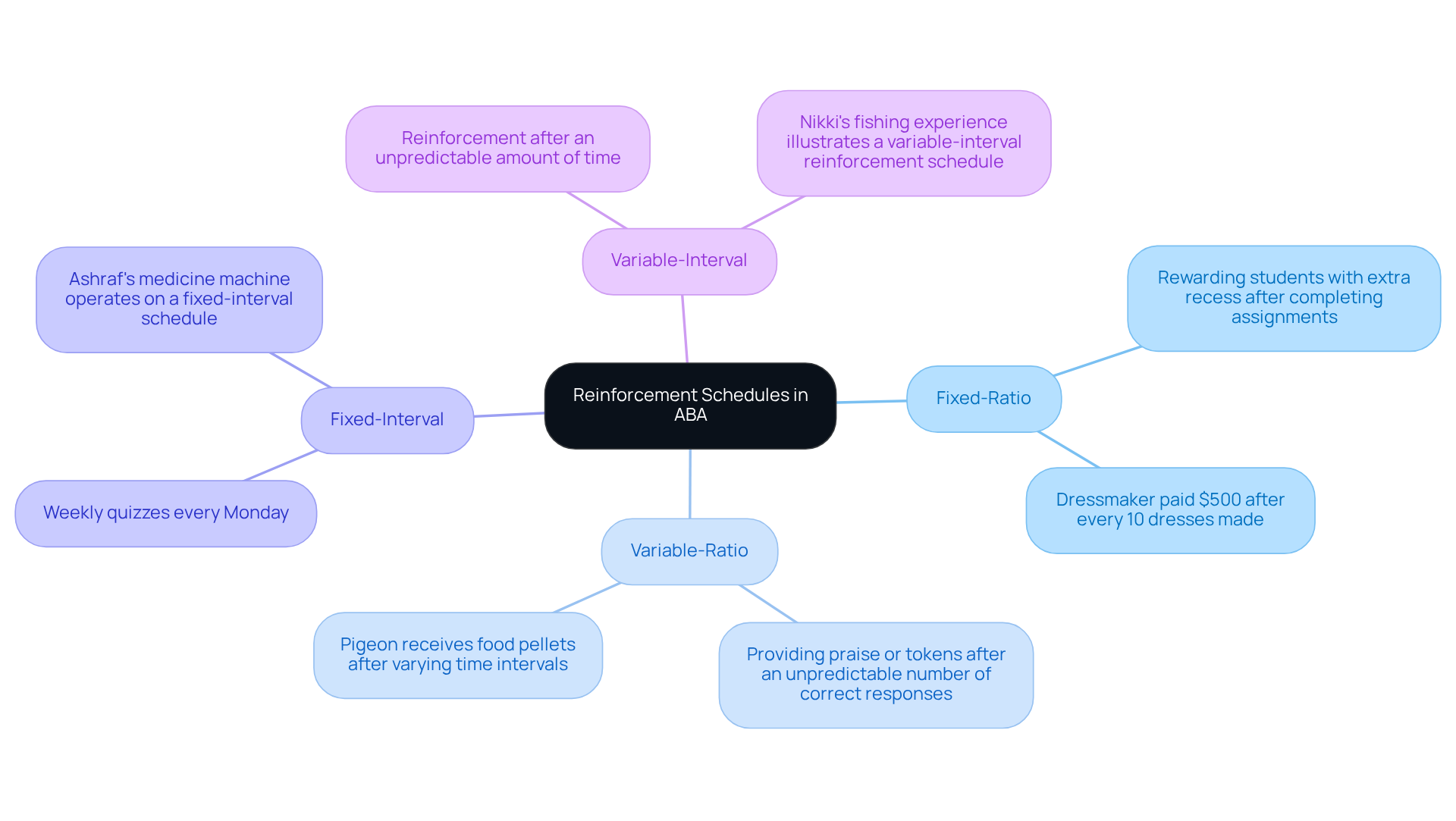
The exploration of reinforcement schedules in Applied Behavior Analysis (ABA) therapy underscores their critical role in effective behavior management. As the demand for qualified Board Certified Behavior Analysts (BCBAs) continues to rise, understanding and implementing various reinforcement strategies—such as continuous, intermittent, fixed, and variable schedules—becomes essential. Practitioners can significantly enhance learning outcomes and foster lasting behavioral change by leveraging these strategies.
Continuous reinforcement is vital during initial learning phases, while intermittent schedules bolster persistence and motivation. Each type of schedule offers unique advantages, from promoting rapid behavior acquisition to ensuring long-term engagement and resilience against extinction. Fixed and variable reinforcement strategies provide structure and unpredictability, respectively, creating environments conducive to sustained behavior. Additionally, employing fading techniques and data-driven adjustments allows for personalized approaches that cater to individual client needs, ultimately leading to more successful interventions.
In light of the complexities of behavior management, it is essential for practitioners to continually refine their understanding of reinforcement schedules. Embracing these strategies not only enhances the efficacy of ABA therapy but also empowers clients toward greater independence and success. The integration of systematic monitoring and real-life applications further solidifies the importance of these reinforcement techniques in achieving meaningful behavioral outcomes.
How can you ensure that your practice remains at the forefront of effective behavior management? Consider the transformative power of these reinforcement strategies and their role in your professional development.
What is Hire ABA and its purpose?
Hire ABA is a specialized recruitment platform designed to connect Board Certified Behavior Analysts (BCBAs) with job opportunities in the field of Applied Behavior Analysis (ABA) therapy. It aims to optimize the hiring process for both job seekers and employers, ensuring that qualified professionals find positions that align with their skills and career goals.
What is the projected demand for BCBAs by 2026?
The demand for Board Certified Behavior Analysts (BCBAs) is projected to surge by 25% by 2026.
How does Hire ABA enhance the job matching process?
Hire ABA leverages data-driven insights to significantly enhance the job matching process, facilitating career advancement for BCBAs in a rapidly evolving landscape.
What is a continuous reinforcement schedule in ABA therapy?
A continuous reinforcement schedule involves offering a reinforcer each time a desired action occurs, which is particularly effective during the initial learning phases. This method strengthens the connection between the action and the reward.
What are the benefits of using a continuous reinforcement schedule?
Continuous reinforcement can lead to swift behavior acquisition, motivating individuals to repeat behaviors due to immediate rewards, such as compliments or small rewards for task completion.
What are the potential risks associated with continuous reinforcement?
A potential risk of continuous reinforcement is extinction, which can occur if the support is withdrawn. It's important to balance immediate rewards with long-term change for successful ABA interventions.
What is an intermittent reinforcement schedule?
An intermittent reinforcement schedule provides rewards only after specific occurrences of the desired action, rather than on a regular schedule, creating unpredictability that fosters stronger and more enduring behaviors.
How does intermittent reinforcement contribute to behavior maintenance?
Intermittent reinforcement encourages persistence in actions, as individuals continue the activity in anticipation of a reward. This approach has been shown to improve long-term behavioral change.
What evidence supports the effectiveness of intermittent reinforcement?
Studies indicate that participants under intermittent reward conditions demonstrate greater persistence, with improved response rates over time, highlighting its role in fostering sustained engagement and motivation.
Our expert recruitment strategies and AI-driven sourcing ensure that you receive top-notch candidates quickly, without compromising on quality. Whether you’re looking for BCBAs, Clinical Directors, or RBTs, we’ve got you covered.